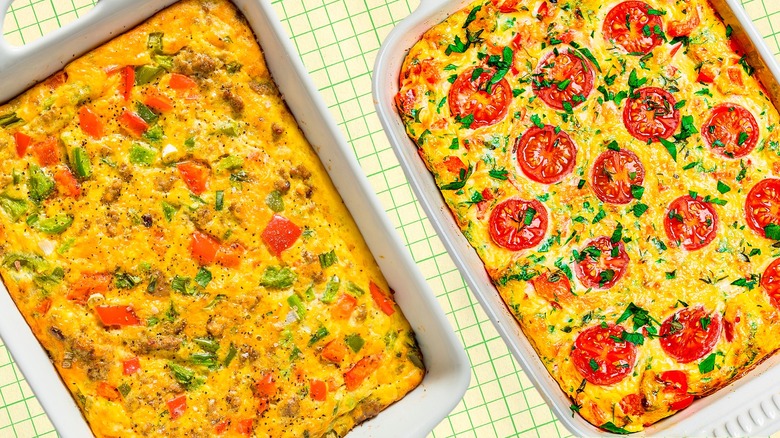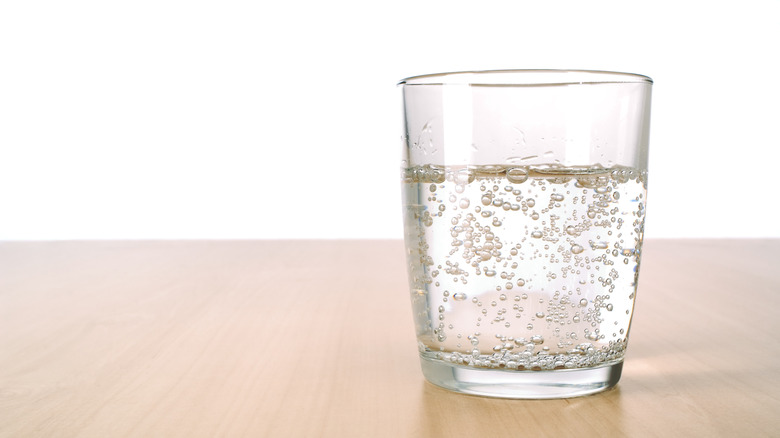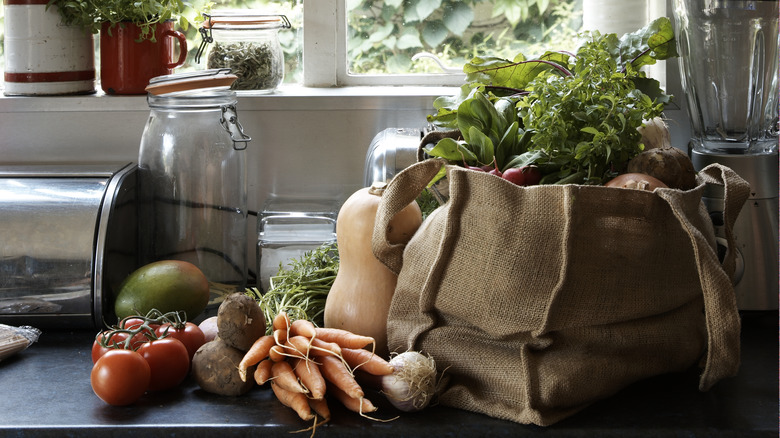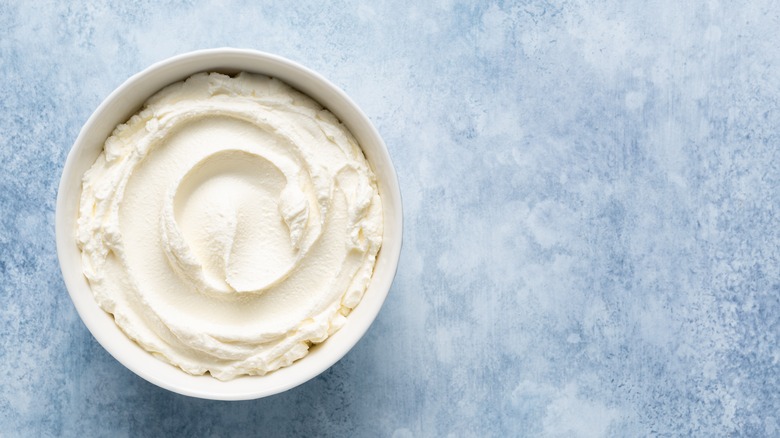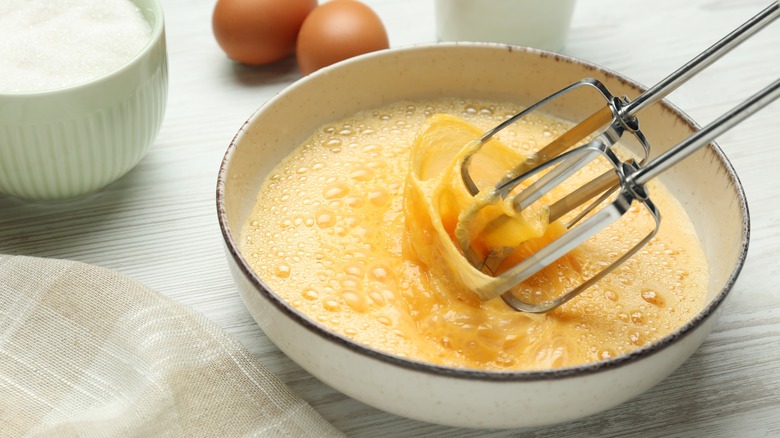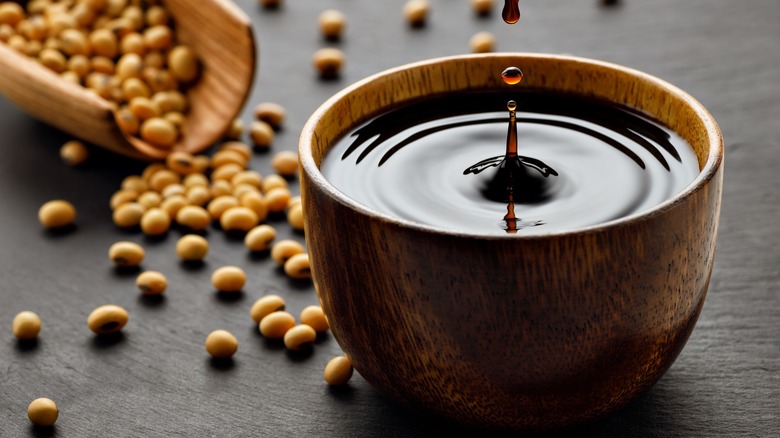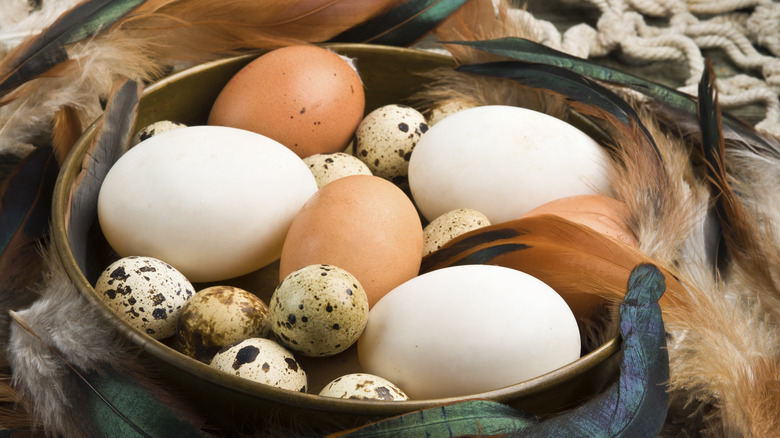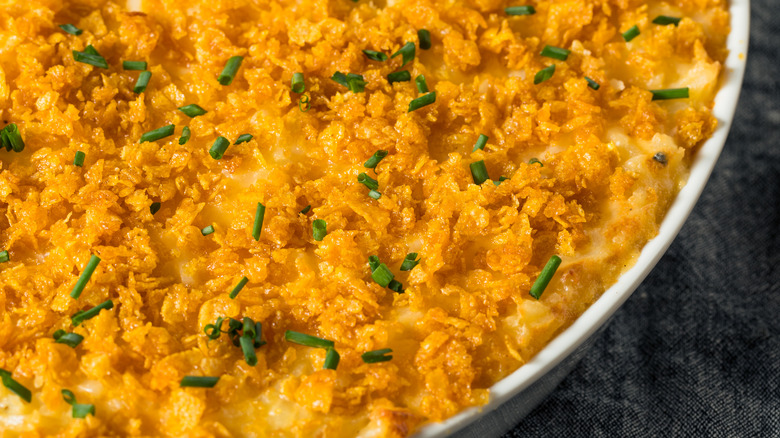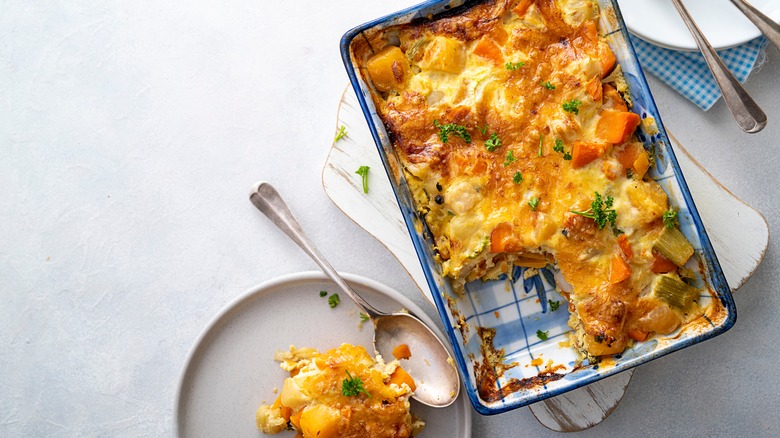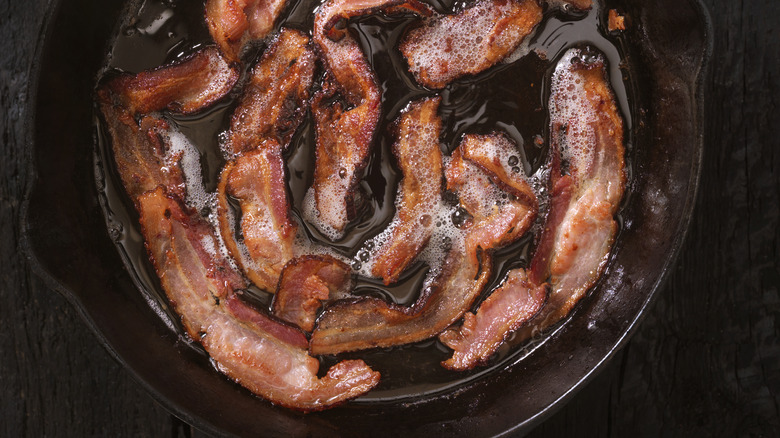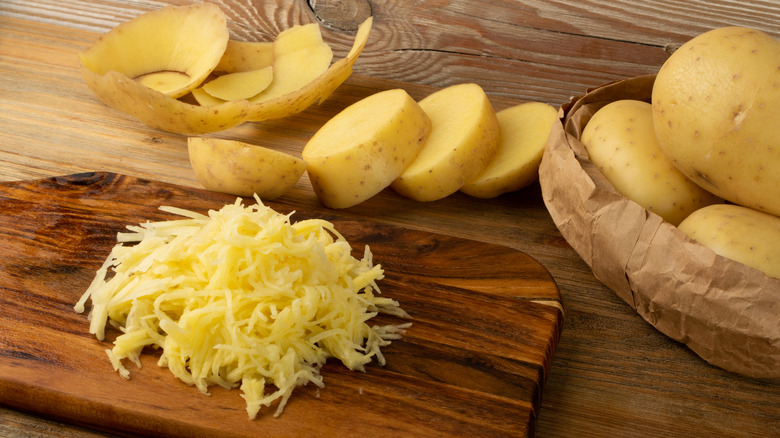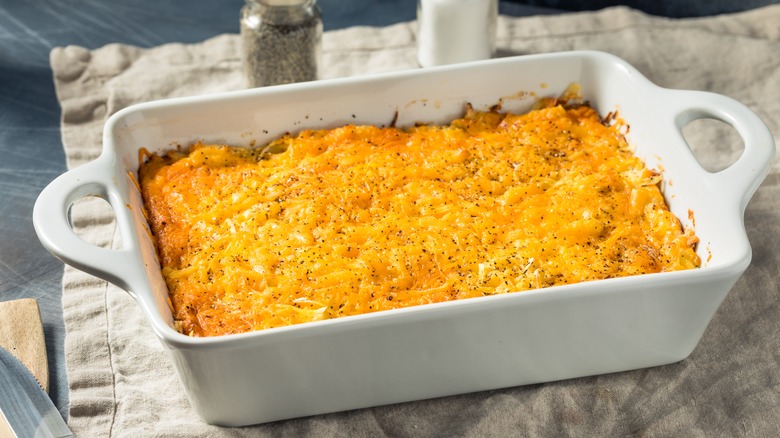12 Hacks That Will Make Egg Casseroles So Much Tastier, According To A Trained Chef
Egg casserole is one of those dishes that can provoke moans of monotony or elated cheers depending on its execution. If done correctly, an egg casserole can be fluffy, light, filling, flavorful, and have quite a range. It should be your new go-to recipe for Sunday brunch because it's quick to make and can feed a crowd. But before you throw up your question marks about this seemingly dated dish, hear us out and apply some hacks that will make egg casseroles so much tastier than your great aunt's rubbery everything-but-the-kitchen sink recipe.
As a chef and recipe designer with a concentrated interest in vegetarian cooking, I like to focus on three important factors when creating a culinary experience: flavor, texture, and presentation. The flavor is a given but is often overlooked in the casserole department as recipes that tend to ingredient dump can lack spices. Next is texture, which is typically the downfall of most egg casseroles. Even a little extra effort to make that fluffy texture shine can go a long way. Lastly, don't just whip everything together and throw it in the oven and call it a day. Layer with care and garnish to draw the eye. With these elements in mind, here are my favorite hacks to use when upgrading a tasty egg casserole.
Add seltzer water
When it comes to egg-hacks, the goal is crystal clear: Create fluffy, airy, light eggs. There are several methods to achieve this texture, but some can be quite extensive and finicky. A quick hack that we use to create the fluffiest scrambled eggs, as well as airy eggs in casseroles, is adding seltzer water to your eggs. I know what you're thinking: doesn't this make your eggs watery? Surprisingly enough, the little bubbles create pockets of air that inflate when exposed to heat. Time to toss out your grandmother's splash of milk (by the way, you should think twice before adding milk to your scrambled eggs) and replace it with a splash of seltzer water instead.
Now, let's get down to the details. Too much seltzer water can flood the recipe, producing watery, rubbery eggs. Too little can have no effect at all. Add about one tablespoon of seltzer water per two eggs. This should allow the eggs to benefit from the carbonation without the liquid pooling. Whip it in like you would do with milk, and get those eggs into the hot oven right away. The quicker you get your eggs to heat, the more you can take advantage of the carbonation before it goes flat. Voila! World-class eggs with minimal effort.
Use fresh, pre-cooked vegetables
In most cases, we recommend using fresh produce in recipes because it tends to carry a better overall flavor and texture. But there is a very specific reason we suggest picking fresh veggies over frozen for the best casserole texture. Firstly, frozen vegetables tend to lose their structure due to the formation of ice crystals, which can make them mushy. It's so important for your vegetables to retain some crunch to add textural variety to your dish, especially because eggs are inherently soft. Next, frozen vegetables tend to release water quickly when heated. You may even find that the water pools around the vegetables unless you thaw them and drain them ahead of time.
Pools of water can result in rubbery eggs. You will want to add no more than a tablespoon of additional liquid per two eggs to keep the perfect ratio, so opt for fresh vegetables. Any intentional liquid should be whipped into the egg batter, not pooled around vegetables. Because vegetables have a higher water content than meat, for example, you may consider lightly pre-cooking your fresh vegetables to release flavor and moisture before incorporating them into the egg mixture. This will ensure a low water content, and help to sweeten up those vegetables.
Whip soft cheese directly into your eggs
While cheddar cheese dominates the breakfast scene when it comes to egg dishes, there are other options to consider. Don't get us wrong; we love the sharp taste of cheddar alongside those tender whipped eggs, but using a softer cheese can help make a creamier casserole. Consider whipping your soft cheese directly into the egg mixture, but be sure to do so with vigor so the cheese incorporates evenly into the batter. Instead of little cheddar pockets throughout the casserole, you'll find that the overall dish will change in texture. In addition, softer cheese tends to have a fresher, more mild flavor (in most cases) and will allow your dish to take on a new personality that might not be as predictable.
Choose a cheese like ricotta or cottage cheese. Even a dollop of sour cream can be used to create a creamy texture for your egg casserole. In fact, the secret ingredient in Paula Deen's scrambled eggs is sour cream; who knew? The soft cheese will help keep whipped eggs fluffy and create a moist and irresistible texture that will make your egg casseroles so much tastier. And just because you're adding a softer cheese doesn't mean you have to give cheddar the boot. Try both for the ultimate cheese-laden brunch family favorite.
Whip eggs with an electric beater for light, airy eggs
When considering the texture of egg casserole, it's not just about what ingredients you add. Sure, softer cheese, a splash of seltzer water, and other secret ingredient hacks will make their impact. But it's also important to consider changing up your method. Beating eggs is an art, and not everyone has a wrist that will tolerate such vigorous whipping for an extended period of time. If you don't have what it takes, don't fear; technology can step in to save the day.
Consider using an electric mixer because the more air you can incorporate, the better. This is one of your top tips for the fluffiest scrambled eggs, so it makes sense that it would carry over into an airy, egg-heavy casserole dish. Simply choose the whisk or batter beater attachments and go to town. Alternatively, use an immersion blender. Use this opportunity to add any cheese, spices, or condiments like soy sauce or hot sauce to your eggs so they incorporate flawlessly. The moment your eggs are at peak fluffiness, mix in your meats and vegetables, transfer them to the casserole dish and bake away. At the end of the day, even if you are a master whipper, you may just find that the cooking process is a lot easier, and the outcome is a lot fluffier with using a mixer.
Make egg casserole in your slow cooker
If you own a slow cooker, then you know just how easy pot roasts, soups, pulled pork, and stewed apples can be, but how many breakfast foods have you tried in that magical machine? If your answer is next to none, then it's time you try making egg casserole in your slow cooker. This little hack will make your egg casseroles so much tastier and, more notably, that much easier. No need to wake up first thing in the morning to pop your bake in the oven; instead, set and forget overnight.
Now, cooking eggs overnight is vastly different than a pork butt or chicken. Eggs must be cooked at a very low temperature to ensure they don't overcook and become dry, stiff, or rubbery. It's important to add dairy to your slow cooker egg casserole to keep it creamy and moist, and you'll want to follow your recipe's directions carefully when programming your slow cooker to the optimal settings. Whether its guests arriving in the morning for brunch, or your kids are early risers, it's best to do the bulk of the cooking before you go down for the night, and a slow cooker breakfast casserole recipe ensures that you'll get that extra hour of sleep that you deserve.
Add depth by using soy sauce instead of salt
If you're not familiar with umami, then your culinary world is about to change forever. Umami can be described as a meaty, balanced, savory flavor that, although it can be mistaken as salty, is quite unique. Some ingredients that hold this complex flavor include mushrooms, tomato paste, miso, soy sauce, and egg yolks. It's quite enjoyable, and because eggs naturally have a mild umami flavor, it can be nice to accentuate that with umami additions to your casserole.
A simple way to highlight the umami flavors is by adding soy sauce instead of salt to your casserole. If you aren't familiar with the different types of soy sauces, stick to a darker, richer sauce. For those with a gluten allergy, choose tamari instead of soy sauce or use miso paste. When adding soy sauce, keep in mind that it is very salty, and a little bit goes a long way. In fact, just a teaspoon can transform your entire casserole and have it bursting with umami flavors.
Use duck eggs for a fancier occasion
Chicken eggs are the default when dining out, grocery shopping, and breakfast foods. Not all eggs are interchangeable in recipes, but it's safe to say that fowl eggs can be swapped in breakfast dishes, especially casseroles. But why stray from the classic chicken egg? Well, if you've ever tasted duck eggs, then you know they are different in both appearance and flavor. Duck eggs are larger, a deeper orange, and richer in flavor. This is the reason that many top-tier restaurants and chefs use duck eggs over the basic chicken variety. This is a great way to add depth and lean into that rich umami flavor that egg yolks are famous for.
However, there are endless varieties of eggs to choose from. If you're looking to bougie up your brunch, consider tracking down some duck eggs for a simple swap that will make your guest drool. Adorn with other cream-of-the-crop ingredients like pancetta, shiitake mushrooms, and shallots. Garnish with fresh herbs and truffle oil, and don't forget to serve it on a pre-warmed plate! Casseroles are forgiving, so take this opportunity to flex your muscles and think outside of the box!
Add a crunch with cornflakes
Once you've mastered getting your eggs fluffy as can be, it's time to focus on other elements of texture that will make your egg casseroles so much tastier. Texture is often overlooked by novice cooks, but seasoned chefs (no pun intended) will tell you that texture is an extremely important element to every dish and deserves careful consideration. For casseroles, it's essential to ensure the eggs have a light and airy texture, but the next step is to create variety. You can do this by adding chewy and buttery ingredients like crispy bacon or soft caramelized onions, but one of our favorite hacks that will make your egg casserole so much tastier is the addition of crunchy cornflakes.
While this hack works for a variety of casserole dishes, we think it's elite in an egg casserole because it plays with the breakfast theme beautifully. Simply toss cornflakes in oil or melted butter before sprinkling them over your unbaked casserole. If you choose to mix the eggs beforehand and refrigerate the mix overnight, be sure to add the cornflakes in the morning just before it goes into the oven. This cornflake coverage can be used in most casserole dishes.
Choose 3 or fewer vegetables to include
Often, people decide to make casseroles because they have a refrigerator full of produce that is about to go bad and want to use it up. And while a veggie-loaded egg casserole can be delicious, if you're going for a chef-quality dish, you may want to ease up on the gas pedal and do a little bit of planning. It can be tempting to go veggie-wild, but it's best to stick to a theme and select flavors that complement each other without overpowering the egg. For reference, use three or fewer vegetables and no more than one meat.
There are certain vegetables that pair best with your morning eggs, and those are a great place to start when planning your recipe. Consider narrowing your search to seasonally appropriate vegetables. For instance, in the fall, you might gravitate towards kale, mushroom, and fennel, while in summer, you may use yellow zucchini, asparagus, and cherry tomatoes topped with fresh parsley. Sometimes, simple is best when using high-end ingredients. A duck egg casserole with grated truffles and fresh ricotta or simply using caramelized onions along with gruyere cheese can make a recipe sing. The fewer ingredients, the more you can enjoy each flavor.
Always drain your meat to avoid rubbery eggs
We love an egg casserole loaded with meat, but have you ever noticed the more meat you add, the less airy your eggs turn out? The reason for this is that when meat is cooked, its fat goes from solid to liquid. All of this excess liquid floods the eggs and creates a rubbery texture. But no worries, this doesn't mean you have to forgo meat in your egg casserole altogether. The fix is simple and doesn't require much extra effort. The hack that can help preserve the texture of your eggs is to always drain meat before adding it to a casserole.
This doesn't require much extra effort because you must pre-cook meat before adding it to your raw egg mixture anyway. Simply use a paper towel to blot away excess liquid, strain the meat with a slotted spoon or strainer, or pour it out of the pan. Even if it's just a few teaspoons worth of liquid, it could make all the difference. Before draining your meat in the sink or pouring fat down the drain, take a moment to recognize that once it cools back to room temperature, it will solidify. Save yourself the steep bill for a plumber and pour it into a jar to dispose of, or save it to cook your vegetables in later.
Include hash browns in your mix
There are many creative ways to use hash browns outside of the side dish capacity, and we think egg casserole is a great example of this. First, it's a given that hash browns and eggs go together like peanut butter and jelly because they are both classic diner breakfast foods. Second, hash browns can take on several different textures depending on how they are incorporated. If mixed directly into the beaten eggs like in this cheesy hash brown casserole recipe, it can add density and moisture to the dish.
However, if your favorite part of hash browns is their crispy texture, then we recommend pressing it into the bottom of your oiled dish to create a crunchy base or sprinkling it on top to create a crispy crust. An easy way to achieve this is by spraying the potatoes lightly with oil. It's also important to season your shredded potatoes, so they contribute to the dish's flavor instead of mellowing it out. Both potatoes and eggs are mild, so a little salt and pepper can go a long way.
Sandwich your eggs with cheese
I think we can all agree that there is nothing more delicious than broiled, crispy, ooey-gooey cheese. It's savory, salty, fatty, and can carry a variety of textures depending on the cooking method. Luckily, cheese has many applications when it comes to egg casserole. Soft cheese and shredded cheese can be whipped into the egg mixture itself, but creating a cheesy crust is a creative way to layer the casserole with flavor.
Instead of mixing in your sharp cheddar cheese, sprinkle it on top for a beautiful, bubbly brown topping. Also, try lining your pan with cheese, producing a lasagna-like crust on the bottom. Who isn't enticed by the enchanting allure of melted cheese? If the cheese has melted but hasn't bubbled, toss it under the broiler for a few minutes. Keep a close eye on it and be cautious when baking cheese under the broiler because it can easily burn. A low broil can help ensure a more even browning, and remember that in less than a minute, your cheese could be overdone. Even if you've whipped a softer cheese into your casserole, a cheesy crust can add even more flavor and depth.
